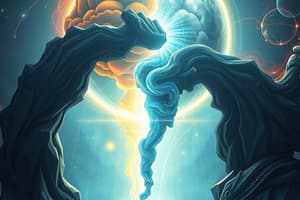Podcast
Questions and Answers
What stage of adolescence involves preparing for adult roles and considering future plans?
What stage of adolescence involves preparing for adult roles and considering future plans?
- Youth
- Pre-Adolescence
- Middle and Late Adolescence (correct)
- Early Adolescence
What physiological factor primarily contributes to the changes observed during puberty?
What physiological factor primarily contributes to the changes observed during puberty?
- Proteins
- Nutrients
- Enzymes
- Hormones (correct)
According to Erik Erikson, what is essential for personal growth during adolescence?
According to Erik Erikson, what is essential for personal growth during adolescence?
- Financial independence
- Clear personal identity (correct)
- Peer acceptance
- Career development
Which of the following best defines an identity crisis?
Which of the following best defines an identity crisis?
What term describes the overall evaluation of how one perceives oneself?
What term describes the overall evaluation of how one perceives oneself?
In James Marcia's theory, which status occurs when an individual has made commitments without experiencing a crisis?
In James Marcia's theory, which status occurs when an individual has made commitments without experiencing a crisis?
What describes the significant transition from childhood to adulthood?
What describes the significant transition from childhood to adulthood?
What is a common physical change during adolescence?
What is a common physical change during adolescence?
Which statement accurately reflects the timing of middle and late adolescence?
Which statement accurately reflects the timing of middle and late adolescence?
During which developmental stage do self-consciousness levels tend to peak?
During which developmental stage do self-consciousness levels tend to peak?
Which of the following best describes the concept of 'moratorium' in identity development?
Which of the following best describes the concept of 'moratorium' in identity development?
What role do hormones primarily play during adolescence?
What role do hormones primarily play during adolescence?
What does the term 'crisis' encompass within adolescent development?
What does the term 'crisis' encompass within adolescent development?
What is a key characteristic of self-esteem as it pertains to identity?
What is a key characteristic of self-esteem as it pertains to identity?
Which period does not accurately represent a critical transition in identity formation?
Which period does not accurately represent a critical transition in identity formation?
Which of the following represents a significant achievement expected during adulthood?
Which of the following represents a significant achievement expected during adulthood?
Study Notes
Self-Identity and Body Image
- Adolescence marks the significant transition of childhood to adulthood.
- Middle and late adolescence is between the ages of 11-21
- Adolescence is a crucial period for self-development.
- Identity is an awareness of who you are and what you are capable of.
- Self-image is how you envision yourself, including your strengths and weaknesses.
- Self-esteem is how you feel about yourself, based on your self-image.
- Hormones play a significant role in physical development during adolescence.
- Physiological changes, such as puberty, lead to increased self-consciousness.
- James Marcia's Four Identity Statuses:
- Identity Achievement: Achieved a sense of self through exploring and committing to various options.
- Identity Foreclosure: Acceptance of values and goals instilled by authority figures, without exploration.
- Identity Moratorium: Ongoing exploration of values, beliefs, and goals, without commitment.
- Identity Diffusion: Lack of exploration and commitment to a sense of self.
- According to Erik Erikson, establishing a clear personal identity is crucial during adolescence.
- The middle and late adolescent periods prepare for adult roles, requiring consideration of future aspirations.
- Adulthood is a time for individuals to assert independence and make choices about their path in life.
Self-Identity
- Identity gives a sense of individuality.
- Middle and late adolescence occurs between the ages of 11-21.
- Physiological change is when self-consciousness peaks.
- Adolescence is the period of significant transition from childhood to adulthood.
- Hormones help organs and tissues perform their functions.
- Most physical changes occur in the late part of adolescence.
- Establishing a clear personal identity is important during adolescence.
Identity Development
- Erik Erikson's theory: Establishing a clear personal identity, is important at this stage.
- James Marcia's theory: Psychosocial development has desired outcomes after going through a specific crisis.
- Middle and late adolescence are the periods of preparation for adult roles, which require an individual to consider what they plan to do in the future.
- Adulthood is the period of quest for identity and individuality.
Terms
- Self-Esteem: How a person sees themselves
- Maturation: The process of becoming mature
- Crisis: A crucial period in the development of an individual, An event or state or condition that affects the individual.
- Adolescence : A crucial period in the development of an individual, An event or state or condition that affects the individual
- Hormones: A chemical substance that passes through the bloodstream to reach different organs and tissues.
- Identity Crisis: A sense of not knowing who you are.
- Puberty: The period in life where a boy and a girl undergo bodily changes, they become sexually mature.
- Physical changes: Physical changes are quickly occuring in adolescence, including length, height, and weight increases.
- Moratorium: Transition to the late part of adolescence when an individual develops specific preferences
James Marcia's Four Identity Statuses
- Identity Achievement: The individual has explored different options and made a commitment to a specific identity.
- Identity Moratorium: The individual is actively exploring different options, but has not yet made a commitment to a specific identity.
- Identity Foreclosure: The individual has made a commitment to a specific identity, without fully exploring other options.
- Identity Diffusion: The individual has not explored different options and has not made a commitment to a specific identity.
Studying That Suits You
Use AI to generate personalized quizzes and flashcards to suit your learning preferences.
Description
Explore the critical concepts of self-identity and body image during adolescence. This quiz delves into how self-image, self-esteem, and developmental changes impact adolescents aged 11-21. Learn about James Marcia's Four Identity Statuses and their significance in personal development.




